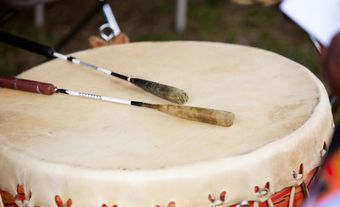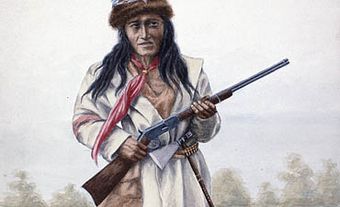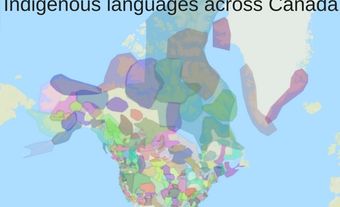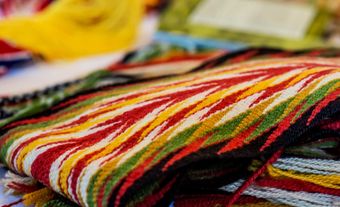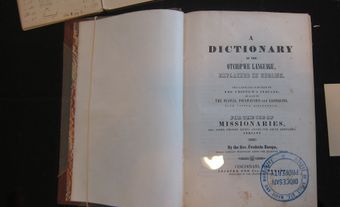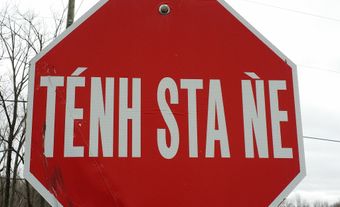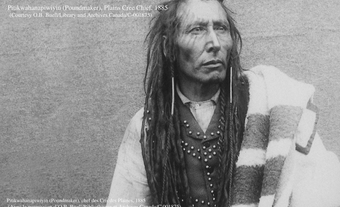The Cree language (also called Cree-Montagnais-Naskapi) is spoken in many parts of Canada, from the Rocky Mountains in the west to Labrador in the east. Cree is also spoken in northern Montana in the United States. Often written in syllabics (i.e., symbols representing a combination of consonant and vowel, or just a consonant or vowel), Cree is one of the most widely spoken Indigenous languages in Canada. In the 2021 census, 86,475 people reported speaking Cree.

The Language and Its Dialects
The Cree language is often described by linguists as a dialect continuum (a series of dialects that change gradually over a geographical area), also called Cree-Montagnais-Naskapi. This dialect continuum belongs to the Algonquian linguistic family, and is spoken across Canada, from the Rocky Mountains to Labrador. ( See also Indigenous Languages in Canada).
(courtesy Native Land Digital / Native-Land.ca)
From the west to the east, these dialects include:
- Plains Cree, also known as the y-dialect (spoken in much of Alberta, central Saskatchewan and Manitoba, and northern Montana) (See also Plains Indigenous Peoples in Canada.)
- Woods Cree, also known as the th-dialect (spoken in northern Manitoba and Saskatchewan) (See also Subarctic Indigenous Peoples in Canada.)
- Swampy Cree, also known as the n-dialect (spoken in northern Manitoba and Ontario)
- Moose Cree, also known as the l-dialect (spoken in northern Ontario)
- James Bay/Eastern Cree (spoken mainly on the lower east coast of Hudson Bay and the east coast of James Bay). James Bay/Eastern Cree has a northern and southern dialect
- Attikamek (Atikamekw) also known as the r-dialect (spoken in central Quebec)
- Montagnais (spoken in north-central Quebec and on the north shores of the St. Lawrence River and Gulf of St. Lawrence)
- Naskapi (northeast Quebec and northern Labrador)
Some of these dialects, including Plains Cree and Eastern Cree, have their own subdialects.
Cree dialects differ in phonology and grammar. Most commonly, dialects will alternate sounds — and the spelling of those sounds — in various Cree words. For example, Plains Cree speakers call their language nehiyawewin (using the letter y), whereas the Swampy Cree say nehinawewin (using the letter n instead of y). Due to the differences among dialects, Cree speakers in one part of the country might not understand Cree speakers in another.
The Cree language has influenced other Indigenous languages, including Oji-Cree and Michif. While both languages include elements of Cree, they are typically considered distinct.
Syllabics: Writing Cree
The Cree language can be written using syllabics, which are symbols that represent a combination of consonant and vowel, or only a consonant or vowel. Over time, the Cree modified their writing system to adapt to local dialect variation and to increase its phonetic accuracy (i.e., correspondence of sound to alphabet symbol).
Historically, credit for the Cree writing system (known also as the Cree syllabary) has been given to Reverend James Evans, a Christian missionary at Norway House in present-day Manitoba. Evans produced considerable printed material in syllabics, including hymns and portions of the New Testament. However, many Cree peoples have contested this story. Oral histories say that Mistanâkôwêw (also known as Calling Badger) from Stanley Mission, Saskatchewan, delivered the writing system to the Cree.
Syllabics are written and read horizontally from left to right. Each character indicates a consonant sound, and, when flipped, also denotes an attached vowel. For example, in the Eastern Cree dialect, the syllabic for p (ᐯ) is rotated to indicate the following vowels:
|
pwe |
pe |
pi |
pii |
pu |
puu |
pa |
paa |
pwaa |
|
ᐺ |
ᐯ |
ᐱ |
ᐲ |
ᐳ |
ᐴ |
ᐸ |
ᐹ |
ᑆ |
Not all Cree-Montagnais-Naskapi dialects use syllabics. Attikamek, Montagnais and Eastern Naskapi typically use the Roman alphabet instead. Plains Cree, Woods Cree, Swampy Cree, Moose Cree and Eastern Cree can also take the Roman alphabet.
Did You Know?
Cree is one of 11 official languages recognized in the Northwest Territories.
Current State of the Language
Cree is one of the most widely spoken Indigenous languages in Canada. In the 2021 census, 86,475 people reported speaking Cree, the majority of whom live in Saskatchewan, Alberta and Manitoba.
An additional 6,740 people identified as Attikamek speakers, and 11,605 as Innu/Montagnais and Naskapi languages. While Statistics Canada identifies these as distinct from Cree, many linguists identify them as part of the same dialect continuum.
Despite its status as a widely spoken Indigenous language in Canada, Cree is still a declining mother tongue. In 2021, Statistics Canada reported that the number of speakers of Cree languages dropped by 6.1 per cent. Many cultural and educational institutions strive to preserve and promote the language.

 Share on Facebook
Share on Facebook Share on X
Share on X Share by Email
Share by Email Share on Google Classroom
Share on Google Classroom


